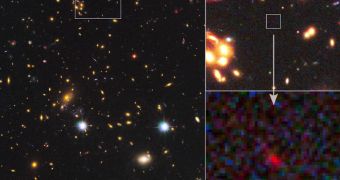Astronomers at NASA recently used two of the space agency's telescopes to image a galaxy that may very well be the most distant ever discovered. The team says that the Universe is 13.75 billion years old, and that this object started developing around 500 million years after the Big Bang.
A quick calculation puts its age at 13.25 billion years. By comparison, the Milky Way began to form when the Cosmos was 3.75 billion years old, much later on. The data used in the new study were collected at both optical and infrared wavelengths.
The NASA/ESA Hubble Space Telescope captured images of the distant galaxy at optical wavelengths, while the NASA Spitzer Space Telescope was responsible for collecting infrared data. The two observatories were aided by a cosmic magnification effect, the team reports.
Astronomers argue that this discovery will have significant implications on our understanding of how the Universe formed. There are several key stages in the evolution of the firmament, including the Reionization Epoch, the dark ages, and the appearance of dark energy, and little is known about them.
Given its age, the distant galaxy must have begun developing at a time when the dark ages were coming to an end, and the Reionization Epoch was getting under way. This basically means that the Universe moved from a state where stars couldn't form to the type of appearance it displays today.
“This galaxy is the most distant object we have ever observed with high confidence. Future work involving this galaxy, as well as others like it that we hope to find, will allow us to study the Universe's earliest objects and how the dark ages ended,” says Wei Zheng.
The expert is the lead author of a new paper detailing the findings, which is published in the latest issue of the top scientific journal Nature. He holds an appointment as a principal research scientist in the Johns Hopkins University (JHU) Department of Physics and Astronomy, in Baltimore, Maryland.
There are currently several candidates for the position of most distant galaxy in the Universe. However, NASA says that this particular one was observed at five different wavebands, giving the discovery additional credibility. Other candidates are only seen in one waveband.
Starting in 2018, with the launch of the NASA James Webb Space Telescope (JWST), astronomers will be able to investigate objects such as this one with greater efficiency. The observatory will be especially well suited for conducting investigations on the first lights ever to emerge in the Universe.

 14 DAY TRIAL //
14 DAY TRIAL //